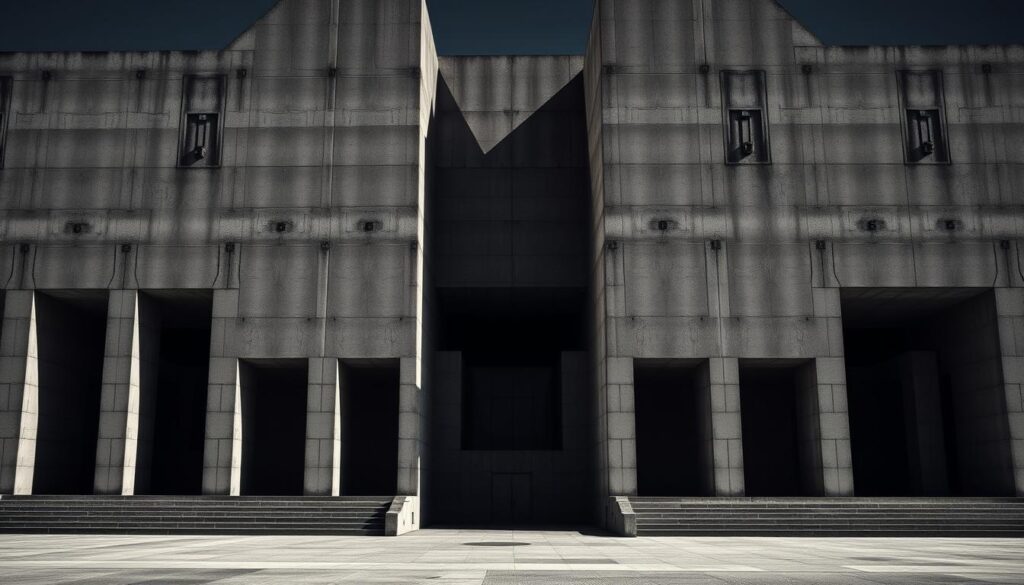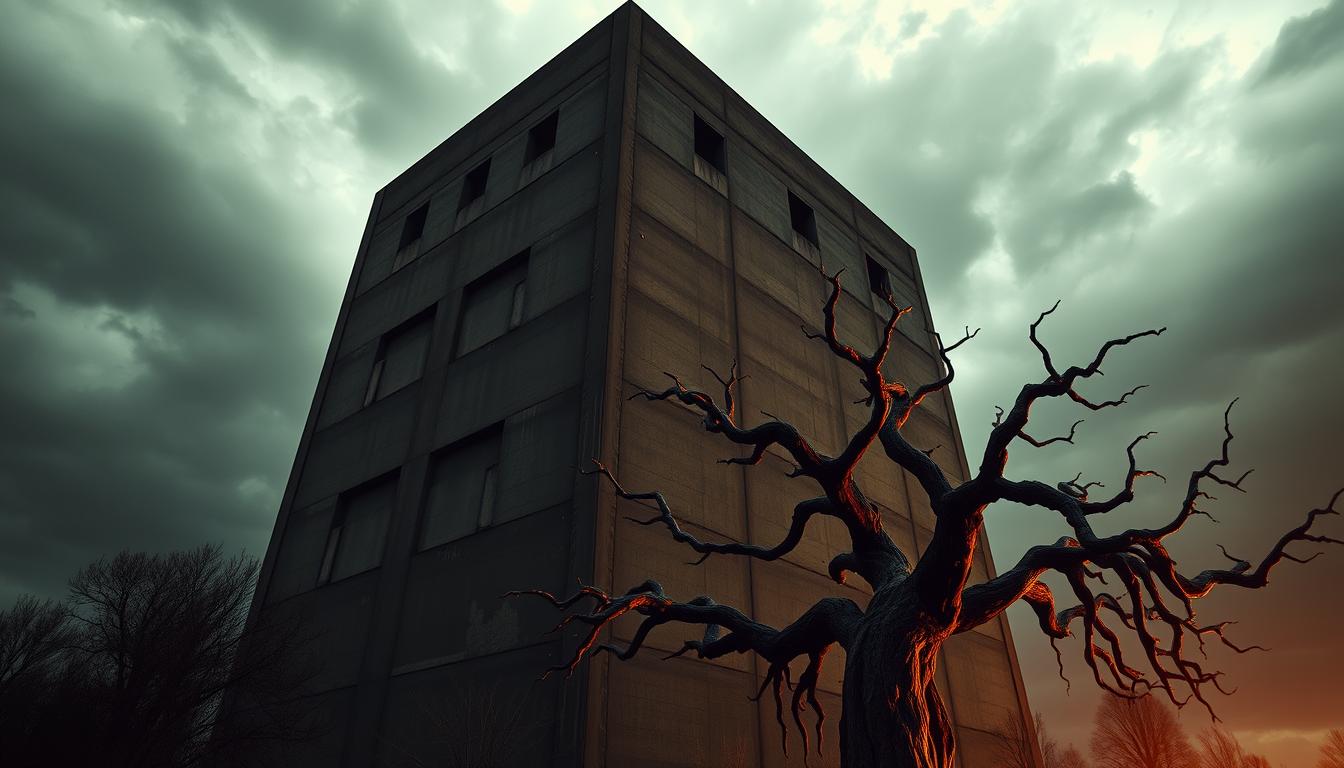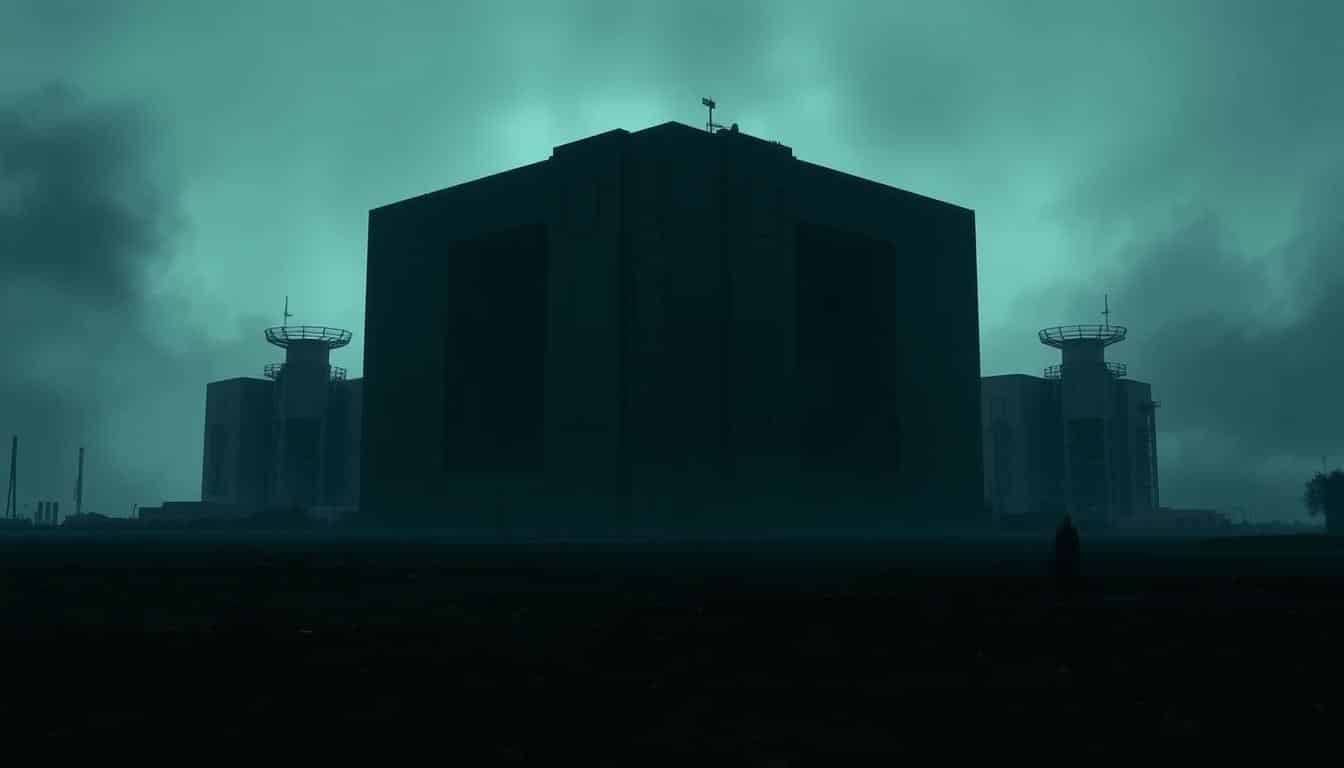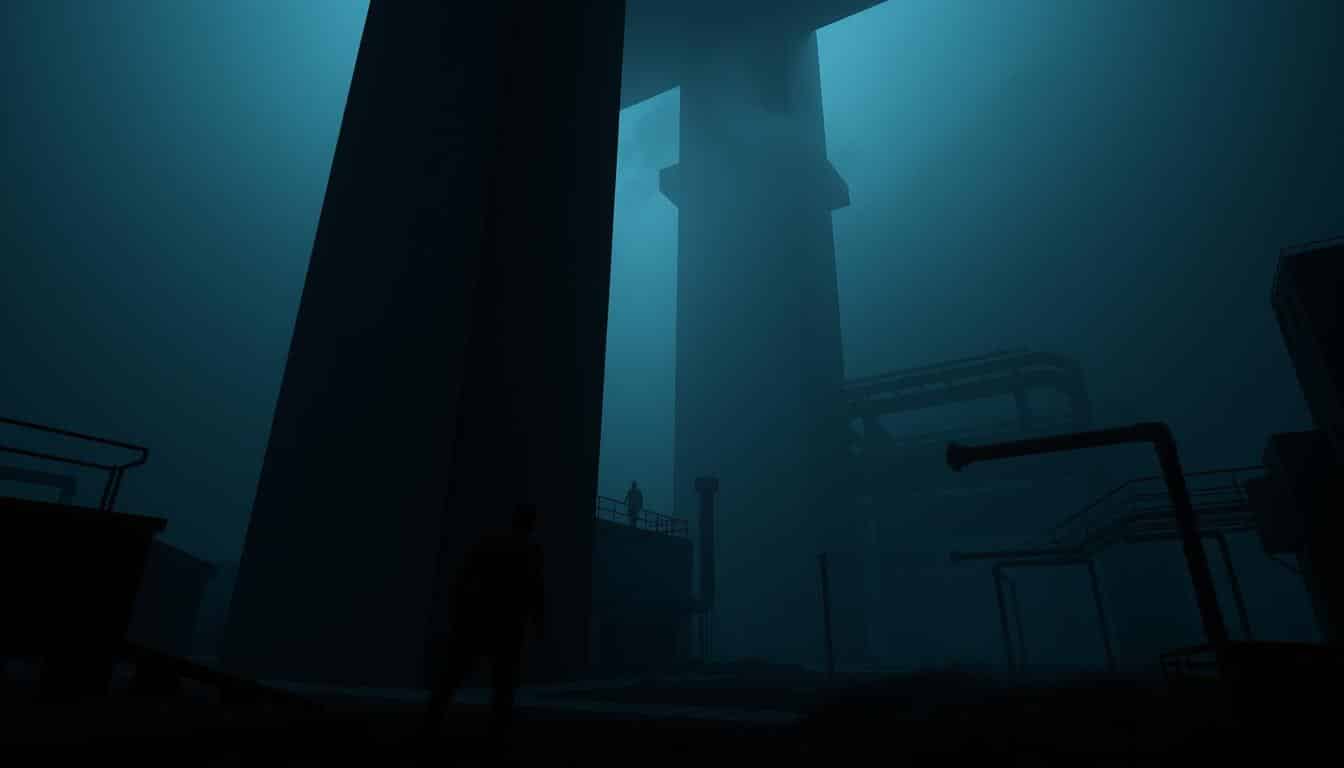In video games, combining brutalist architecture with horror has created something special. These games use stark, oppressive settings to boost fear and anxiety. They take players into a world that’s both fascinating and scary.
As we explore horror games further, it’s clear the eerie look of brutalism is crucial. It’s more than just a backdrop. It’s at the heart of the game, affecting both the story and how we play. This exploration shows why these scary buildings are so powerful in horror games. They push the limits of what makes us afraid.
Understanding Brutalism in Architecture
Brutalist architecture stands out due to its bold, functional design. It started in the mid-20th century, after wars had changed the world. Its goal was to make buildings that were simple, useful, and without too much decoration.
Defining Brutalist Aesthetics
Brutalist buildings are known for their use of raw concrete and simple shapes. They show the beauty of their materials openly, which makes them strong and straightforward. These features make brutalist buildings striking and hard to forget in city scenes.
Historical Context of Brutalism
Brutalism has its beginnings in modernist ideas, coming to life after World War II. Architects then were focused on making practical buildings. They wanted to solve the big need for homes and other buildings quickly. Leaders like Le Corbusier helped start this movement. This led to famous buildings like the Barbican Centre and Boston City Hall. These places show how brutalism left a lasting mark on the way buildings look and feel today.

The Connection Between Brutalism and Horror
Brutalism in architecture links closely to horror themes. The stark, massive structures bring out fear and isolation. They mirror urban decay, triggering feelings of vulnerability and dread.
How Brutalist Architecture Evokes Fear
Brutalist buildings use raw concrete and sharp edges. This look creates creepy environments that make people uneasy. Horror games use these scary visuals to boost the fear factor. Players explore huge buildings that seem threatening. The designs’ coldness deepens the game’s emotional impact.
The Role of Isolation in Horror Gaming
Isolation is key in many horror games. It’s often shown through empty, brutalist settings. Players are in deserted spots, filled with silence. This loneliness adds to the horror, making players more anxious. Brutalism and isolation together make a game you won’t forget quickly.
The Haunting Appeal of Brutalist Structures in Horror Gaming
Brutalist structures bring a unique vibe to horror games with their sharp lines and big shapes. These buildings make games more tense and scary. By looking at how buildings impact games, we see how they help tell stories and make players feel more involved.
Cinematic Influences of Brutalism in Gaming
Movies have a big impact on how games show brutalist architecture. Films like “A Clockwork Orange” and “Blade Runner” use brutalist styles to make their worlds unsettling. This style works well in games too, where the cold, functional look of brutalism adds to the storytelling. The sharp lines and bold shapes of these buildings pull players into the game’s world.
The Impact of Environment on Player Experience
The setting of a horror game is key to how much it pulls you in. Brutalist architecture often feels lonely and forgotten, making the game scarier. These buildings, with their simple insides and intimidating outsides, play with your senses. As players move through these empty places, the game becomes more intense. This sense of no hope or cheer adds to the spooky feel of playing horror games.
Iconic Brutalist Horror Games
Horror video games do more than scare players. They use building designs to make you feel strong emotions. Games like Silent Hill, Resident Evil, and The Evil Within use a style called brutalism to make their worlds extra creepy. Let’s see how these games use that style to make their scary parts even scarier.
Case Study: Silent Hill
Silent Hill is a classic horror game. It uses a style called brutalism to make players feel alone and scared. This matches the main character’s feelings perfectly. The game’s world is filled with fog and broken buildings. It makes you face fears inside and outside as you play.
Case Study: Resident Evil
Resident Evil mixes horror with a brutalist look, especially in places like the Raccoon City Police Department. The building’s cold concrete and sharp shapes make players feel weak and in danger. You have to move through tight, scary spaces. It makes you feel alone and always close to danger.
Case Study: The Evil Within
The Evil Within explores scary, twisted worlds with a brutalist twist. Players are thrown into a nightmare with run-down buildings and strange surroundings. The big, scary buildings confuse you. They make it hard to know what’s real as you try to survive the game’s story.
The Emotional Response Evoked by Brutalist Gaming Environments
Brutalist gaming environments stir deep feelings, thanks to their design and ambience. The stark setting underlines a sense of being alone that can be unsettling. It raises the fear of the unknown. As players explore these empty landscapes, they feel tense and wary.
Every turn might bring danger or fear. This adds to the thrill of the game.
Fear of the Unknown in Desolate Spaces
The design of brutalist structures makes players feel anxious. Empty spaces and sharp shapes make them feel exposed. These features, along with sound, boost the game’s emotional impact.
Action might be absent, but the fear is real. Darkness makes navigating these spaces scary, keeping players on edge.
Building Tension Through Design
The way brutalist horror games are designed adds to the tension. The use of stark lighting and daunting architecture warps the player’s sense of reality. It crafts an atmosphere filled with dread.
Sound effects like echoing steps or groaning walls draw players into a threatening world. These elements blend to affect players on a deep, psychological level. The game becomes an experience that’s both visual and deeply emotional.
The Evolution of Brutalist Aesthetics in Gaming
The journey of brutalist aesthetics in gaming has seen dramatic changes. It moved from simple 8-bit graphics to the immersive worlds of today’s games. This change shows how tech has reshaped game visuals. Indie games have added new ideas to the mix, blending old themes with fresh ways of thinking.
From 8-bit to Modern Graphics
Brutalism in gaming started with basic 8-bit graphics. These early designs captured gamers’ hearts and set the stage for what was to come. As tech improved, so did the quality of game graphics. This led to more complex scenes and realistic effects.
- 8-bit graphics featured simple designs.
- Later graphics had more colors and details.
- Modern graphics give players lifelike experiences.
Influence of Indie Games on the Genre
Indie developers play a big role in gaming’s evolution. They’ve brought new life to brutalist designs in fun, interesting ways. By sticking to brutalism’s key ideas, they mix old vibes with modern stories. Indie games make us see game design as a way to tell stories, with stark scenes and deep messages.
- Indie games focus on being creative, with new ways to play.
- They use simple designs that can be eerie.
- These games push the boundaries, making room for different design ideas.
Player Engagement and Immersion in Brutalist Horror
Brutalist horror games grab players with atmospheric sound and new gameplay. These factors mix to make a haunting, immersive experience. Sound design is key to making the vibe creepy. It boosts the dread felt in brutal settings. Creaks and whispers seem really close, thanks to eerie sounds.
Sound Design and Atmosphere
Sound design is key for drawing players in. It’s not just noise. It shapes the game’s emotional feel. Developers use sounds like distant steps and spooky tunes to create a mood. This mood, along with visuals, grabs players’ senses and feelings. It makes the tension of the brutalist style stronger.
Gameplay Mechanics and Player Agency
Gameplay helps players feel in control. It lets them make choices that change the horror story. In these games, you often find your way through complex spaces.
These spaces are full of spooky challenges. You have to think fast and make smart choices. This makes you feel more involved. You’re not just playing; you’re fighting to survive. Sound, atmosphere, and gameplay together make an unforgettable experience.
Critics’ Perspectives on Brutalist Horror Games
Brutalist horror games have gotten a lot of attention from critics and players. The way design elements work together is often talked about. Critics like to point out how unique the brutalist style is in making game worlds feel real to players.
Industry Opinions on Design Choices
Critics discuss how design in brutalist horror games impacts gameplay and feelings. They highlight:
- Use of stark, geometric shapes to enhance feelings of unease.
- Monochromatic color schemes that evoke desolation and fear.
- The interplay of light and shadow to heighten tension throughout gameplay.
Experts believe these designs are key to the games’ impact. They allow creators to make experiences that stick with players.
Player Reviews and Personal Experiences
Player reviews show various reactions to brutalist horror games. Common feelings include:
- A sense of dread that stems from the environments.
- Joy in discovering the intricacies of sound design that enhance terror.
- Frustration or exhilaration derived from complex gameplay mechanics.
Players’ feedback highlights the effect of brutalist elements. They add to the fear and fun in horror games, influencing how players react.
Conclusion
We’ve dived deep into the world of brutalist horror gaming. We’ve seen how brutalist structures make the atmosphere even spookier. These buildings, with their stark design and big forms, not only make us uneasy. They also draw us into the scary stories told in games like Silent Hill and Resident Evil. The feelings of being alone and afraid of what we don’t know are key to enjoying these games.
The influence of brutalist design in future games looks promising. Developers are finding new ways to use these designs to make games more exciting. With technology getting better, we might see even more creative uses of brutalism. This could make the games feel more real and emotional.
To wrap it up, brutalism in horror games is more than just a look. It’s a big part of what makes these games special. As players explore these carefully made worlds, it’s exciting to think about what’s next. How will brutalism and horror gaming mix in the future? It’s something to look forward to.



